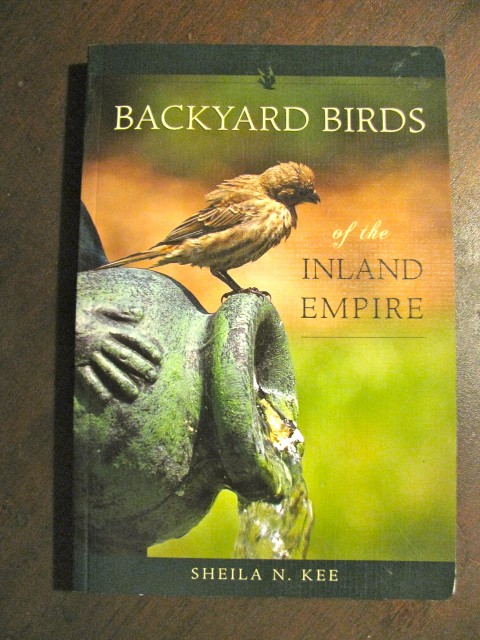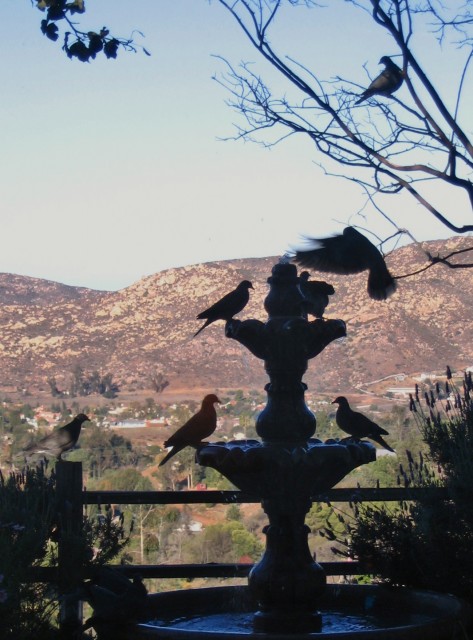“I am not really a bird lister as much as a bird observer. Bird behavior is what fascinates me. – Sheila Kee, book author
If you’re looking for a gift for someone who is a budding bird watcher or who simply enjoys the birds in their yards, I came across a great book – Backyard Birds of the Inland Empire by Sheila Kee. And while her emphasis is birds in inland Southern California, it seems the info on our area’s 50 common birds would be helpful for anyone in the West.
After talking to Kee I know why I liked her book so much. “I am not really a bird lister as much as a bird observer,” she said. “Bird behavior is what fascinates me. I am just as happy watching the birds in my yard and their behaviors, as I am running from ‘hot spot’ to ‘hot spot’ to find unusual birds.”
So it’s not surprising that while each write-up describes the bird’s appearance and their call, she also includes its typical behavior, nesting characteristics and what would attract that bird to your yard.
Other Bird Behavior Books
Before I talk more about her book along with general tips for backyard birding, Kee suggested a couple other birding books that focus on behavior.
- Kee’s all-time favorite is the 1967 published book (republished in 1991) The Birds and the Beasts Were There, which she called “a very funny account of backyard birdwatching in Santa Barbara.”
- Though she hasn’t read it yet, consider a new book “Bird Watching and Other Nature Observations: A Journal.“
- I’ve found Beginner’s Guide to Birds by Donald and Lillian Stokes helpful (especially their section on nesting).
- Kee suggested getting onto Amazon, or Barnes and Noble or a library website and searching under ‘bird behavior’, saying there is a lot available.
 Some of the things I’ve learned from Kee’s book:
Some of the things I’ve learned from Kee’s book:
- As early as January here in Southern California, we can look for nest building by red-tailed hawks, Anna’s hummingbirds, rock doves, robins and the great-horned owls in our neighborhood.
- The nesting description of each species in the book tells which birds raise young as a group, such as the acorn woodpecker. Or the males that help care for the nestlings and young, ranging from the hummingbird males who only serves as a fertilizer – to the mourning dove male that takes turn incubating the nest.
- American crows, mockingbirds, mourning doves and barn owls are monogamous. With the hawks taking so many mourning doves in our yard, monogamy must be hard on them. (I wrote a previous blog Surprising Monogamy among Animals.)
- Hooded orioles nest almost exclusively in the underside of palm fronds and will nest up to three times, which suggests it’s best to trim palms fall through winter.
- Don’t put oats or peanuts at feeding stations if you want to discourage European starlings, which often take over nesting sites from native species. Tying a yellow ribbon to thistle socks will attract American goldfinch who might think it’s a goldfinch, while more cedar waxwings are visiting our yard because we’ve added birdbaths and berry producing plants.

Band-tailed pigeons on our fountain in San Diego. Kee’s book tells which birds are attracted to birdbaths or fountains.
Expanding from your Backyard
Kee has moved to the Northwest – where she says she misses the mockingbirds – but recalled her favorite birding spots if you want to expand from your backyard. “The Inland Empire is so blessed with the variety of habitats, from wetlands to desert to mountains. Two of the best places are the San Jacinto Wildlife Area since it has wetlands and scrub areas and the wonderful trails at the Louis Rubidoux Nature Center in Riverside.” She also recommended the Bearpaw Ranch (open to Audubon members), Joshua Tree National Park and the Salton Sea.
Tips for becoming a better bird observer:
To Kee the most wonderful thing about birds is that “they are everywhere. What a great hobby it makes and it can be done for relatively little expense and absolutely anywhere.”
- Keep a nature diary – Kee noted fun, unusual and interesting things she observed. “It helped me know from year to year when certain birds arrived and when they left… when they began nesting, when there were unusual birds in my yard and, most importantly, what their behaviors were,” she said.
- Observe wherever you are, even if you are in the middle of the city. “Not only will you be surprised perhaps, but you will begin learning what species exist there compared to a natural area. It’s all a learning experience,” said Kee.
- To get good at anything, you need to practice, practice, practice. “Go with people who are better birders than you are – whether friends or the Audubon Society field trips or even a Christmas Bird Count (they are always looking for additional ‘eyes’ even though you may not be a good birder per se).”

Leave a Reply